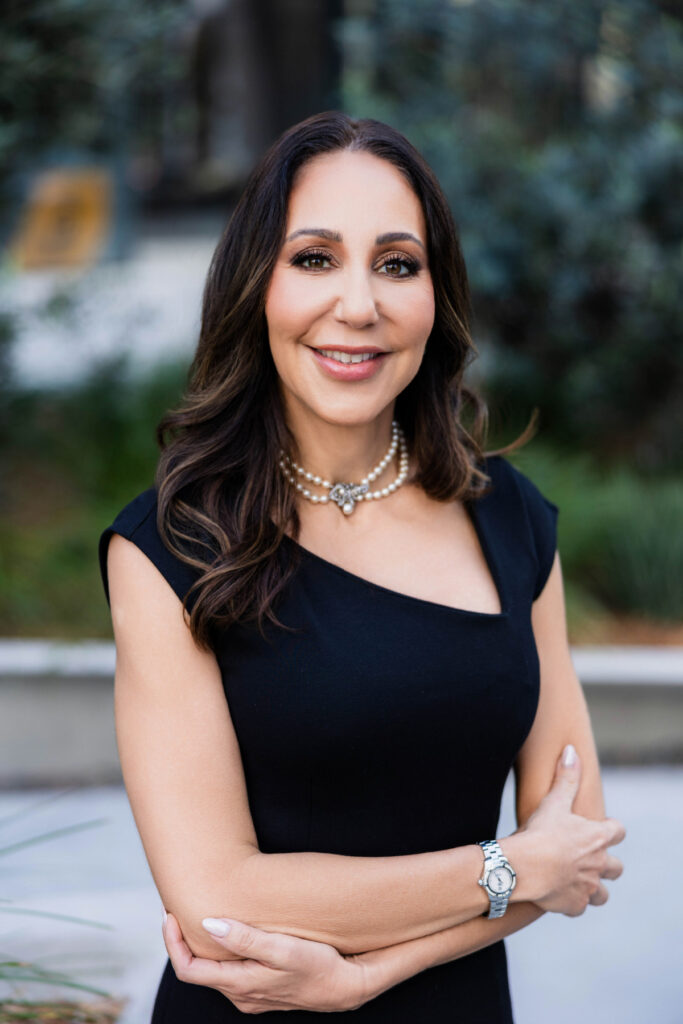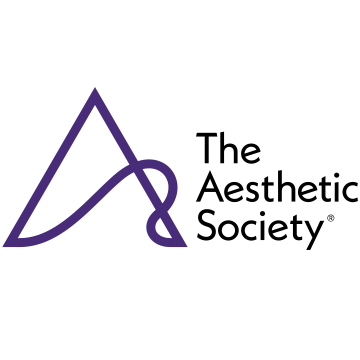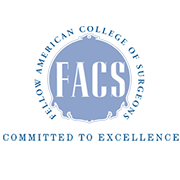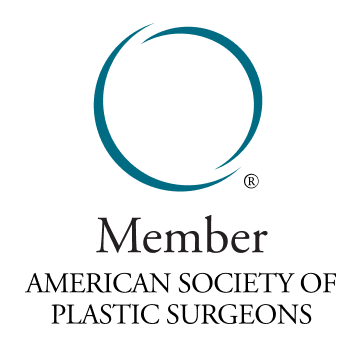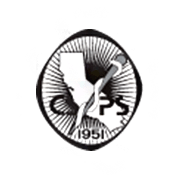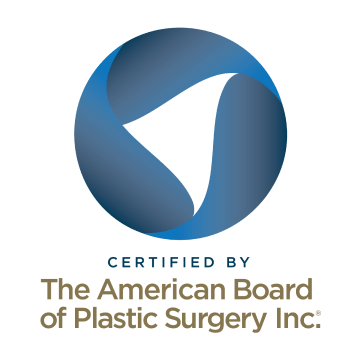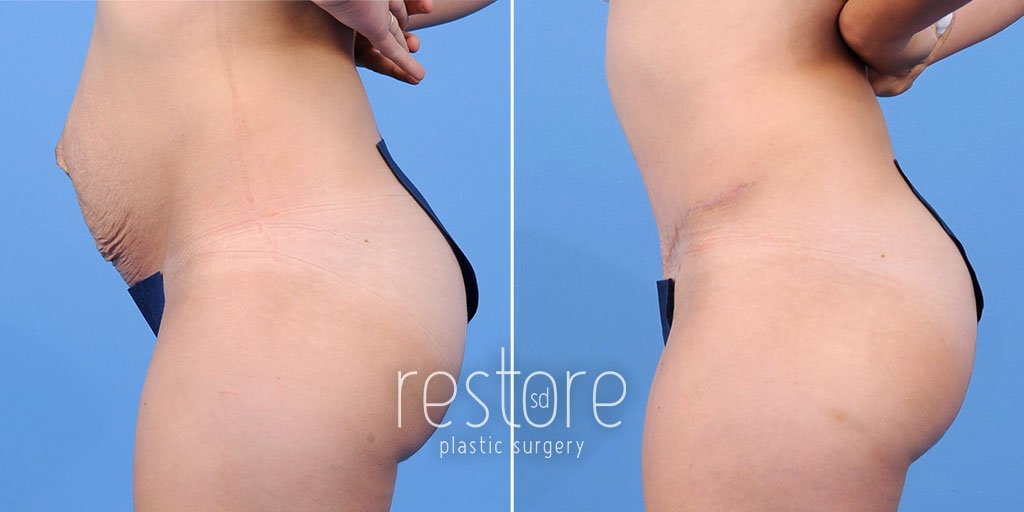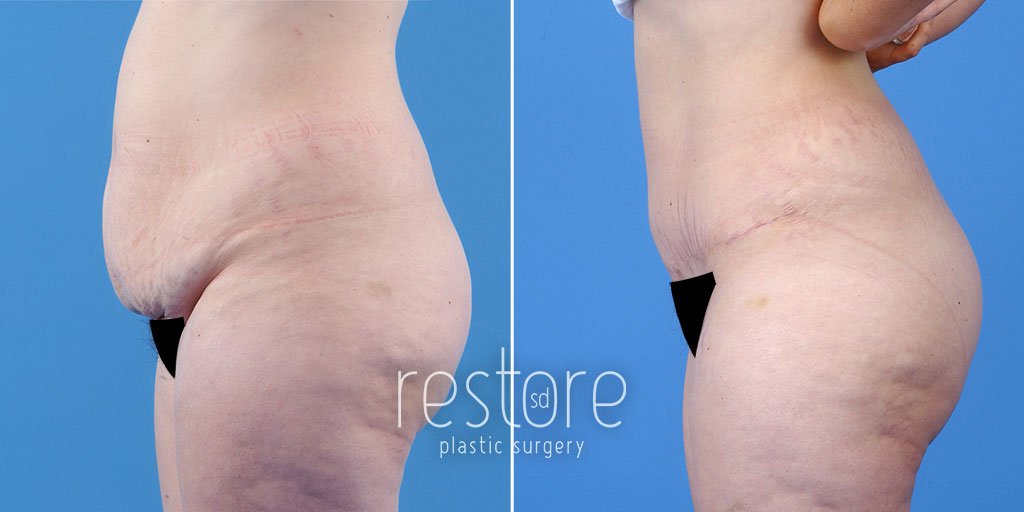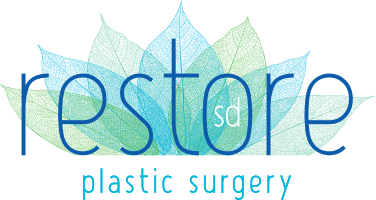Tummy Tuck San Diego (Abdominoplasty)
What is a tummy tuck?
A tummy tuck (abdominoplasty) is a plastic surgery performed to create a firm, sculpted abdomen by:
- Restoring the natural anatomic alignment of stretched abdominal muscles
- Removing excess skin
- Reducing some stretch marks on the lower abdomen
This is one of the most common cosmetic surgery procedures, especially for patients whose abdomens have been affected by pregnancy, weight changes, or aging. Tummy tuck surgery can also repair diastasis recti, or separated abdominal muscles.
Video transcript »
One of the most sought-after procedures that I perform in San Diego is a tummy tuck. It removes all that loose, sagging skin, tightens the abdominal wall, and reshapes the abdomen. It is such a rewarding procedure because sometimes these things cannot be remedied with diet and exercise alone. Actually, the more weight you lose, sometimes that skin can just become more saggy. Most of my patients benefit from a standard tummy tuck with liposuction. This adds additional contouring to really address the waistline and the back area.
My patients that have gone through the tummy tuck procedure are overwhelmingly happy and confident again with their bodies. It is a life-changing operation and has a really, really high patient satisfaction rate.
With over 20 years of experience, Dr. Gallus is a board certified plastic surgeon and Castle Connolly Top Doctor. She will partner with you to develop a tailored surgical plan that prioritizes your safety and results.
Am I a good candidate for tummy tuck surgery?
Good candidates for a tummy tuck procedure…
- Have loose skin (skin laxity) on the stomach from pregnancies or weight loss
- Are motivated to maintain a healthy lifestyle with diet and exercise
- Do not have a history of blood clotting problems such as DVT or PE
- Have a BMI of 30 or less (you can calculate your BMI online)
- Have maintained a stable weight for 4-6 months (within 10 pounds)
- Are not taking blood thinners or using nicotine products
- Are satisfied with their weight prior to body contouring surgery
- Want the self-confidence to wear body conscious clothing
“Tummy tuck” sounds cute, but it is a significant surgical procedure and not to be considered lightly! Since pre-surgical health depends on many factors, board-certified plastic surgeon Dr. Katerina Gallus will help you determine whether or not you are a good candidate for a tummy tuck on an individual basis during your consultation. She will discuss your options and partner with you to develop the best and safest surgical plan to maximize your results.
A tummy tuck is a body contouring procedure; it is not designed as a weight loss operation. If you would like to lose a few pounds or tone up a bit before undergoing surgery, please let us know! Dr. Gallus will be happy to provide referrals for nutrition guidance, medical weight loss, and personal trainers.
Abdominoplasty for men
Men also may desire removal of sagging skin on the abdomen after weight fluctuations. Additionally, notable weight gain that results in a protruding belly can cause the abdominal muscles to separate in a condition called diastasis recti, which a tummy tuck effectively corrects.
Can diet and exercise replace a tummy tuck?
No. Diet and exercise can help you reach your goal weight, but they cannot address loose, sagging skin that remains after major weight loss—nor can they repair stretched, damaged abdominal muscles. We recommend our patients use a healthy lifestyle to reach their ideal weight before surgery, then continue this lifestyle to maintain results!

“I went in for a consultation for a tummy tuck, bbl, and lipo and was very impressed with Dr. Gallus and her staff. She made me feel very comfortable and answered any and every question I had (I had a lot lol). She truly made me feel like she cared about my safety and would do great work to achieve the results I wanted…”
—Actual patient of Dr. Gallus
Your Tummy Tuck Consultation
When you arrive at Restore SD Plastic Surgery, you are our number one priority! We will greet you and ensure we have all the necessary paperwork. Dr. Gallus will review your medical history, discuss any medications you are taking, and perform a detailed examination. This is also an opportunity for an open discussion: What are your concerns, and what are your goals? Dr. Gallus will listen to you and partner with you to develop a surgical plan.
To support this conversation, you will have photos taken with our Vectra 3D imaging system, which uses state-of-the-art Canfield software to visualize potential surgical results. You and Dr. Gallus will look over these together, make adjustments, and discuss the benefits of certain surgical techniques, as well as treatment areas, while viewing your photo series.
Once this conversation is completed, you’ll meet with our patient care coordinator to go over a personalized fee quote for the surgical plan you discussed with Dr. Gallus.
Get the scoop on surgical consults »
The Surgery Date: Your Doctors, Incisions, & Anesthesia
When you arrive for your surgery, you will meet with Dr. Gallus to discuss any questions you have and review your surgical plan. Your surgery will be performed in our on-site, Quad A-accredited operating room for your safety. You will be completely asleep under general anesthesia. Our board-certified anesthesiologist Dr. Mohamed Ibrahim will provide your anesthesia and closely monitor you for the duration of your surgery. You will also have a TAP block, which is an injection of local anesthesia placed by Dr. Gallus during surgery to numb the abdominal area and minimize post-operative pain.
Dr. Gallus understands how important it is to a woman to have an incision be in the best place for a patient’s results but also low enough that you will be able to easily hide your scar with undergarments or a bikini bottom. During surgery an incision is made across the lower stomach, from approximately hip bone to hip bone. An additional small incision is made around your belly button. Through these incisions, your rectus muscles (the six-pack muscles) are tightened, and the excess, loose skin on the lower abdomen is removed. The remaining skin of your abdomen is carefully re-draped and your belly button is brought out through a small incision.
For some patients, we place a drain in the incision to promote healing after surgery. Your incision is meticulously closed in layers, and surgical tape is applied. You will be placed in a post-operative compression garment before you move to the recovery room.
Reduced pain with local anesthetic (ultrasound-guided TAP block)
You will be prescribed medication to help manage pain after surgery, but this is not the only method of pain management that you will have! During surgery, Dr. Gallus injects a local numbing medication directly into the abdomen. This technique is called a transverse abdominis plane (TAP) block, a kind of nerve block. Dr. Gallus uses ultrasound to inject this numbing medication very precisely between layers of muscle, where nerves are located. This reduces pain in the immediate period after surgery, which allows you to move around (ambulate) more easily. Patients report much more comfortable recoveries, and the ability to get back to normal more quickly, when we use this technique to complement oral medications.
What happens to my belly button during a tummy tuck?
Your belly button stays right where it is during surgery. The upper abdominal skin is pulled tight, and after the excess skin is removed and the initial closure started, a small hole is cut in the middle of the abdominal skin to bring your belly button through the opening. It is inset with absorbable sutures. (If you have a belly button hernia, that can be repaired within the same operation.)
Your Procedure Options for Abdominoplasty Surgery
Many patients come to their consultation expecting to discuss one surgery, but end up choosing a somewhat different procedure after meeting with Dr. Gallus! Advances in surgical technique and technology continue to improve the results that are possible with body contouring surgery: For most of our tummy tuck patients, we combine liposuction with a tummy tuck to remove unwanted fat and maximize their tummy tuck results (this combination has been used for many years and is considered to be safe.) Due to its safety profile, Dr. Gallus utilizes the SAFELipo technique.
Mini Tummy Tuck
In addition to a traditional tummy tuck technique, Dr. Gallus offers a mini tummy tuck (also called a “limited scar tummy tuck” or “mini-abdominoplasty”), which may be sufficient to reach your goals if your loose skin is located mostly below the belly button. Every individual has a unique body type that affects your surgical plan, as well as the final placement of your incisions! Dr. Gallus will work closely with you before surgery to ensure we create a surgical plan that is tailored to your lifestyle, your body, and your desired results.
Video transcript
“A standard tummy tuck involves an incision from hipbone to hipbone. It also includes repairing the diastasis recti, so those six-pack muscles are brought together. They’re usually stretched out with major changes in weight and most commonly pregnancy. A mini tummy tuck might involve just a short incision and the removal of some lower excess skin.”–Dr. Katerina Gallus
What should I do to prepare for plastic surgery?
In the weeks leading up to surgery, be sure to eat nutritious foods to set yourself up for more optimal healing. Additionally, remember to have your recovery space prepared and make plans for a loved one or friend to stay with you after surgery. It’s also best to wear a button-down, front-opening shirt—wrestling a shirt over your head is the last thing you’ll want to do after surgery!
The Recovery
You’ll need to plan on down time after a tummy tuck so that your body has time to heal with minimal scarring, and following our regimen also helps to minimize complications and promote a beautiful healing process! As our patient, you will have thoughtful post-surgery care and attention from our staff.
Video transcript »
Tummy tuck surgery is one of the most rewarding procedures that I perform. Although women are sometimes concerned about the recovery or the incisions, it is such a life-changing operation. Women are so pleased to have their shape back after either multiple pregnancies or weight changes that it is worth the extra few weeks of recovery time.
One can expect about two weeks of no heavy lifting and no raising your heart rate or blood pressure, so taking things slow. And then an additional total of four to six weeks where you really have to start slow and can’t engage in any super intense activities. That means CrossFit junkies, runners, and Peloton enthusiasts need to take a break for about six weeks.
It’s also important to make sure that you have enough support during your recovery. So, a common question I get is whether an abdominoplasty or tummy tuck recovery is similar to a C-section. I often say, sort of, in that most people don’t recall a C-section as being painful, and abdominoplasty seems more painful because you don’t have the distraction of a newborn and the excitement of having a new baby. So, during abdominoplasty time or tummy tuck time, it is time to focus on you and your recovery and make sure you have that support system in place for after surgery.
My patients that have gone through the tummy tuck procedure are overwhelmingly happy and confident again with their bodies. It is a life-changing operation and has a really, really high patient satisfaction rate.
Most tummy tuck complications occur from getting too active, too early, so select a surgical date that allows an appropriate amount of time to heal and gradually return to more vigorous activities. Tummy tuck is a major surgical procedure, and planning ahead is the best way to ensure you allow yourself enough time to recover. Here is what you can expect during recovery from tummy tuck surgery:
- You will need help from a friend or loved one. After surgery is completed, you will be able to go home with a responsible adult. They should remain with you for a few days as you recover. (If you have very young children, you will need an extra set of hands for a longer period of time!)
- You will need someone to drive you while you are taking narcotic pain medication. Plan to have a friend or family member drive you to and from appointments during the early recovery period!
- You will experience some soreness. Prepare for some soreness in your stomach that should resolve steadily over the first week or two after surgery. Your comfort during the recovery process is important to us, so you will have pain medication, a muscle relaxant, and a stool softener prescribed.
- You will wear a compression garment. To improve results and promote healing, you will need to wear your compression garment for 4-6 weeks after surgery.
- You will have restrictions for about 6 weeks. You will be restricted from lifting anything heavier than your purse for the first few weeks. You can shower the first day after surgery, but you cannot swim in the ocean or the pool, or soak in a tub, for 2 weeks after surgery. You will also need to avoid flying or traveling by car more than an hour or two at a time for the first few weeks after surgery. Most patients continue to make a steady recovery, and you should be able to resume your usual activities within 6 weeks of your abdominoplasty.
- Dr. Gallus will be there for you every step of the way. During the first several weeks of your recovery period, Dr. Gallus will see you frequently for follow-up visits! She will be available to answer any questions you have, and she will guide you back to your usual activities gradually.
To enhance your peace of mind during recovery, we can arrange for you to hire a private nurse to assist you in the first few days after surgery. Or, some patients may choose to spend a few days recovering in proximity to our office in beautiful La Jolla.
- Key Benefits
- Glossary
Key Benefits of Tummy Tuck Surgery
- Removes excess skin and fat for a flatter, more toned abdominal area
- Repairs and tightens stretched or separated abdominal muscles (diastasis recti)
- Reduces some stretch marks located on the excised skin
- Corrects a ventral hernia by addressing weakened abdominal muscles
- Abdominoplasty – The medical term for a tummy tuck, a surgical procedure that removes excess skin and fat from the abdomen and tightens the abdominal muscles to create a smoother, firmer abdominal profile.
- Anesthesia – Medications administered during surgery to prevent pain and discomfort; tummy tuck surgery typically requires general anesthesia.
- Body Contouring – A range of surgical procedures aimed at reshaping and refining the contours of the body; a tummy tuck is considered a form of body contouring that specifically targets the abdominal area.
- Compression Garments – Specialized clothing worn after surgery to reduce swelling, support the abdominal area, and help the skin conform to the new body contours; essential for post-tummy tuck recovery.
- Diastasis Recti – A condition characterized by the separation of the abdominal muscles along the midline, commonly seen after pregnancy or significant weight changes, which can be repaired during a tummy tuck.
- Drainage Tubes – Temporary tubes placed under the skin to drain excess fluid from the surgical site, often used after abdominoplasty to reduce swelling and prevent fluid accumulation.
- Excess Skin – Skin that has been stretched due to pregnancy, weight gain, or aging and does not retract after weight loss, which can be removed during a tummy tuck.
- Extended Tummy Tuck – A more comprehensive version of the standard tummy tuck that removes excess skin and fat from the abdomen and flanks (sides), offering more extensive body contouring benefits.
- Liposuction – A surgical procedure used to remove fat deposits from specific areas of the body, which can be performed in conjunction with a tummy tuck for enhanced body contouring.
- Mini-Abdominoplasty – A less extensive version of a tummy tuck that focuses on removing excess skin and fat from the lower abdomen and may involve less muscle repair.
- Panniculus – The medical term for the overhanging apron of skin and fat that can occur in the lower abdomen, particularly after significant weight loss, which is removed during a tummy tuck.
- Recovery Time – The period required for healing after a tummy tuck, during which patients may need to limit physical activity and follow specific care instructions to ensure optimal healing.
- Scar Care – Practices and treatments recommended post-surgery to minimize the appearance of scars, including the use of silicone sheets, gels, and proper wound care.
- Seroma – An accumulation of fluid under the skin at the surgical site, which is a possible complication after a tummy tuck, often managed with drainage.
- Skin Tightening – The process of removing excess skin and tightening the remaining skin for a smoother, firmer appearance, a key component of the tummy tuck procedure.
- Stretch Marks – Streaks or lines that appear on the skin due to rapid stretching, some of which may be removed or reduced during the skin excision part of a tummy tuck.
- Ventral Hernia – A bulge of tissues through an opening in the muscles of the abdomen, which can occur due to weakened abdominal muscles and may be repaired during a tummy tuck.
Tummy Tuck Results
You will have a slimmer abdominal contour right after surgery, and you will begin to get a sense of your new look in the weeks following surgery when you remove your compression garment to shower. However, swelling and scarring continue to fade for 9-12 months, so most doctors consider your results to be “final” about one year post-op. In our before and after gallery, most after photos are taken at the 6-month mark.
Surgeries related to tummy tucks
Fleur-de-lis abdominoplasty
If you have undergone significant weight loss, you may benefit from a more extensive body contouring procedure than a tummy tuck can provide. Post-weight loss patients may choose to have a fleur-de-lis tummy tuck that removes more excess skin via an additional vertical incision.
Lower body lift
For extensive lower body contouring after losing a significant amount of weight, it may be desirable to remove excess skin or alter the contours of the body with a lower body lift (belt lipectomy), which addresses excess skin of the torso from all angles.
Combination procedures
To meet your body contouring goals, tummy tuck may be safely combined with several other contouring procedures, including liposuction, breast augmentation, breast lift, gluteal fat grafting (Brazilian butt lift, or BBL), or breast reduction surgery.
Abdominoplasty as part of a mommy makeover
After pregnancy in particular, it is common to combine a tummy tuck with a breast augmentation, breast lift, and/or liposuction—this procedure combination is called a mommy makeover. In certain cases, facial rejuvenation procedures can also be performed at the same time as a tummy tuck, including facelift and/or neck lift, eyelid lift, fat transfer, and brow lift. During your free plastic surgery consultation, Dr. Gallus will review your complete medical history and discuss procedure combinations that can be safely performed together to optimize your results.

“One of the greatest challenges after significant weight loss is the feeling of being trapped in a wrinkly lump of loose skin. Dr Gallus and her amazing team were so kind and generous in helping me peel away not only my extra skin, but in feeling like it was the right thing for me. She’s taken care of my abdomen, breasts and arms. The scars are very minimal and I feel absolutely amazing. If you’re considering plastics, you can’t go wrong with coming to her.”
—Google Review for Dr. Gallus
Frequently Asked Questions About Tummy Tucks
Tummy Tuck Surgery Videos
Does a tummy tuck get rid of C-section scars & stretch marks?
The 3 types of tummy tucks
What happens to the belly button after a tummy tuck?
Why does board certification matter in plastic surgery?
Is anesthesia safe?
Better Safe Than Sorry! The Guide to Getting Ready for Plastic Surgery That You NEED
Biggest Fears About Anesthesia
Before You Book: What to Expect During a Plastic Surgery Consultation
Choose board -certified plastic surgeon Dr. Katerina Gallus for your tummy tuck in San Diego
Board certified plastic surgeon Dr. Katerina Gallus holds over 20 years of experience as a cosmetic and reconstructive surgeon. Her priority is taking the time to listen to your goals and partner with you to develop the best and safest surgical plan that will optimize your results and leave you looking and feeling your best. She and her expert medical spa team also offer a full range of premium non-surgical treatments.
Call our office at 858-224-2281 or reach out online to schedule your personal consultation today!
Your Safety = Beautiful Results
Tummy Tuck at Restore SD
At Restore SD Plastic Surgery, patient safety comes first. Board-certified plastic surgeon and former Navy plastic surgeon Dr. Katerina Gallus operates in a private, on-site Quad A-accredited surgery center, with state-of-the-art equipment and LED surgical lighting. She proudly works with a board-certified anesthesiologist and holds privileges at Scripps Memorial Hospital La Jolla.
References »
Regan JP, Casaubon JT. Abdominoplasty. [Updated 2023 Jul 24]. In: StatPearls [Internet]. Treasure Island (FL): StatPearls Publishing; 2024 Jan-. Available from: https://www.ncbi.nlm.nih.gov/books/NBK431058/
American Society of Plastic Surgeons. Tummy Tuck: Abdominoplasty (https://www.plasticsurgery.org/cosmetic-procedures/tummy-tuck). Last reviewed 2022. Accessed 4/25/2024.
The Aesthetic Society. Tummy Tuck (https://www.theaestheticsociety.org/procedures/body/tummy-tuck). Last reviewed 4/28/2020. Accessed 4/24/2024.
Matarasso A, Swift RW, Rankin M. Abdominoplasty and abdominal contour surgery: a national plastic surgery survey. Plastic and Reconstructive Surgery. 2006. doi: 10.1097/01.prs.0000209918.55752.f3.
Shermak MA. Abdominoplasty with Combined Surgery. Clinics in Plastic Surgery. 2020 Jul;47(3):365-377. doi: 10.1016/j.cps.2020.02.001.
Klinger M, Klinger F, Giannasi S, Bandi V, Vinci V, Catania B, Lisa A, Veronesi A, Battistini A, Giaccone M, Caviggioli F, Maione L. Aesthetic and Functional Abdominoplasty: Anatomical and Clinical Classification based on a 12-year Retrospective Study. Plast Reconstr Surg Glob Open. 2021 Dec 20;9(12):e3936. doi: 10.1097/GOX.0000000000003936. PMID: 34938642; PMCID: PMC8687729.
Swanson E. Prospective Clinical Study of 551 Cases of Liposuction and Abdominoplasty Performed Individually and in Combination. 2013. Plastic and Reconstructive Surgery Global Open.
Medically reviewed by Dr. Katerina Gallus — Updated on Oct 28, 2025
Tummy tuck blog posts
 Is it Easier to Lose Weight After a Tummy Tuck? A Female Plastic Surgeon ‘Weighs’ In.
Is it Easier to Lose Weight After a Tummy Tuck? A Female Plastic Surgeon ‘Weighs’ In. 6 Things You Didn’t Know About Tummy Tuck Recovery
6 Things You Didn’t Know About Tummy Tuck Recovery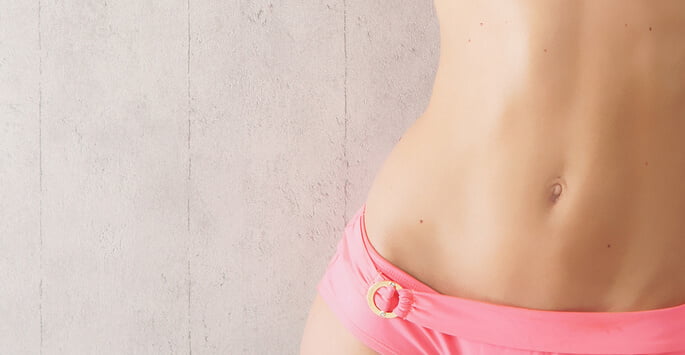 When Should You Get a Tummy Tuck Instead of Liposuction?
When Should You Get a Tummy Tuck Instead of Liposuction?


